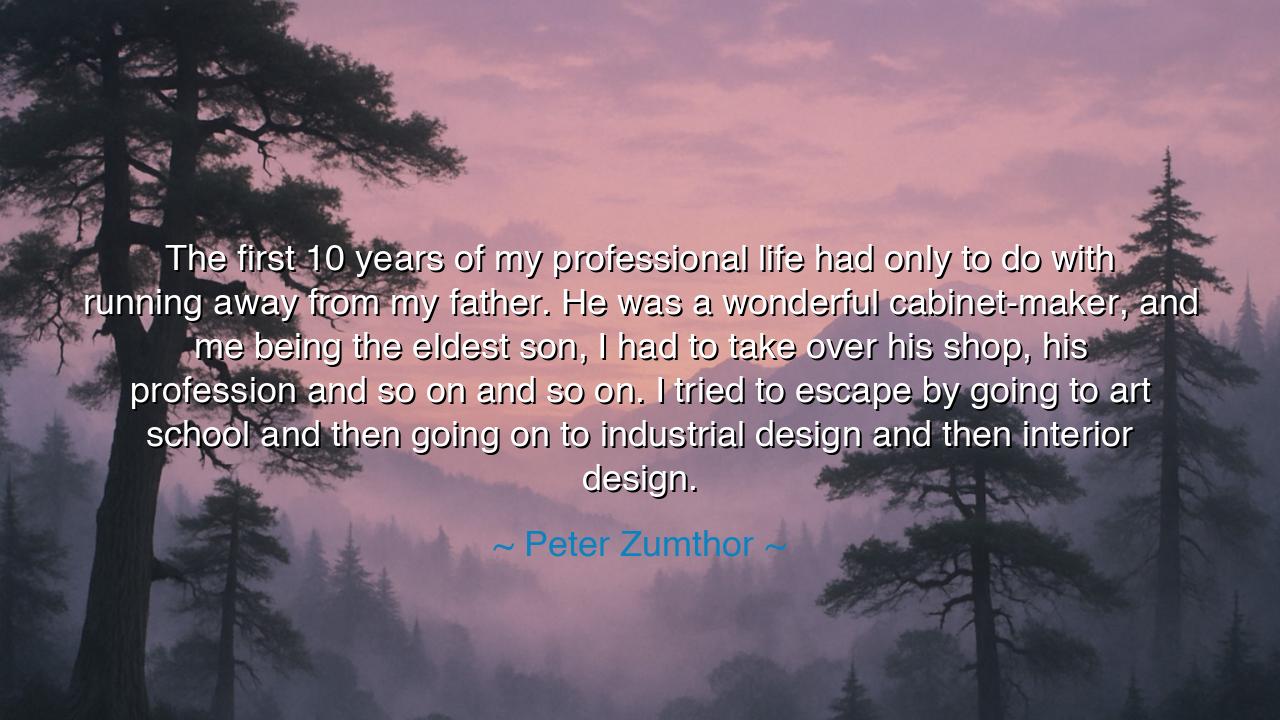
The first 10 years of my professional life had only to do with
The first 10 years of my professional life had only to do with running away from my father. He was a wonderful cabinet-maker, and me being the eldest son, I had to take over his shop, his profession and so on and so on. I tried to escape by going to art school and then going on to industrial design and then interior design.






“The first 10 years of my professional life had only to do with running away from my father. He was a wonderful cabinet-maker, and me being the eldest son, I had to take over his shop, his profession and so on and so on. I tried to escape by going to art school and then going on to industrial design and then interior design.” Thus spoke Peter Zumthor, the Swiss architect whose works breathe silence, light, and timeless grace. In this confession lies the story of a man’s flight from inheritance—and his ultimate reconciliation with it. His words speak not only of rebellion against a father’s craft, but of the deeper human journey to discover one’s own calling, even when it hides in the very shadow we flee.
Zumthor’s reflection reveals the tension between tradition and individuality, a struggle as old as humankind. The son inherits the tools of the father, but the spirit within him yearns to shape the world in a new way. He speaks of his father with respect—“a wonderful cabinet-maker”—yet behind the admiration lies the burden of expectation. The eldest son, destined to take over the workshop, the lineage, the life already defined. And so, Zumthor did what all seekers must do: he ran. He ran not from his father’s love, but from the weight of continuity, the fear that his hands might never create something truly his own. This, dear listener, is the struggle of every creator—to balance heritage and freedom, to honor one’s roots without being buried by them.
The origin of this quote lies in Zumthor’s early years, when his journey as an artist took shape through rebellion. He entered the world of art, then industrial design, and finally architecture, seeking forms of creation that differed from his father’s humble craft. Yet, like many who run from their beginnings, he found himself circling back—discovering that the discipline, precision, and love of material that his father taught had already seeped into his soul. What he sought to escape became his foundation. The cabinet-maker’s son became an architect whose buildings possess the same care, warmth, and devotion to craftsmanship that a fine cabinet holds in its grain. In running from his father, he unknowingly carried him forward.
The ancients knew this truth well: that one must often depart to truly return. Odysseus, in his long voyage, sought glory and knowledge across distant seas, yet all his trials brought him back to Ithaca, to the home that had shaped him. So it was with Zumthor. His art school, his studies in design, his wanderings through abstraction—all were his own odyssey. And when he returned to his roots, he did not inherit the father’s shop as it was; he transformed it. He elevated the spirit of craftsmanship into the realm of architecture, turning wood, stone, and light into sacred experience. Thus, what began as an act of rebellion became an act of continuation—an evolution of inheritance, not a denial of it.
There is a quiet heroism in this journey: the courage to step away from what is expected, to risk failure and misunderstanding in pursuit of authenticity. Too many souls live within the confines of another’s dream, mistaking duty for destiny. Yet true honor to one’s ancestors lies not in imitation, but in interpretation. The father who carves wood and the son who shapes buildings are not opposites, but two verses in the same poem of creation. The son’s rebellion is the father’s legacy renewed. In this way, Zumthor’s flight was not betrayal, but devotion—the kind of devotion that seeks truth, even when truth demands distance.
Let us also remember the tenderness hidden within his words. For Zumthor does not speak of resentment, but of love restrained by fate. His father’s hands built with precision; his own built with space and light. Yet both sought the same thing: beauty born of honesty. The son’s art did not erase the father’s—it extended it, from the cabinet to the cathedral, from the tangible to the transcendent. And so, the story of Peter Zumthor is the story of every artist who grows beyond the master, yet forever bears the imprint of the master’s touch.
So, my child, take this teaching to heart: you must sometimes flee what you love to understand why you love it. Do not fear the impulse to run—it is the soul’s way of finding its own shape. But remember also to return, for in returning you will see with new eyes. Whatever your father’s craft may be—his trade, his wisdom, his silence—carry its essence within you, not as a chain, but as a compass. Create not in his image, but in his spirit. For the truest inheritance is not the workshop you take over, but the integrity you continue.
Thus, the lesson of Zumthor’s words is this: rebellion and reverence are two halves of creation. One breaks the mold; the other remembers why it was made. Run if you must, explore, discover—but when you build, build with the patience of your ancestors and the courage of your own heart. Then, and only then, will your work—like Zumthor’s—carry the eternal harmony between heritage and self, between what was given and what was found.






AAdministratorAdministrator
Welcome, honored guests. Please leave a comment, we will respond soon